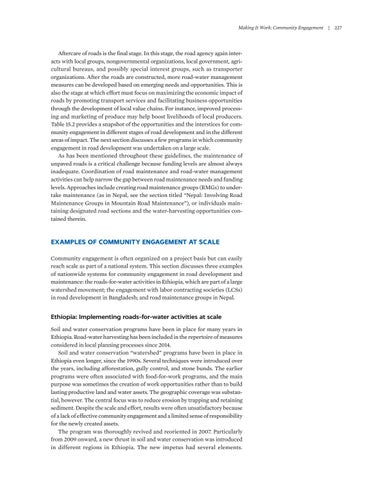Making It Work: Community Engagement | 227
Aftercare of roads is the final stage. In this stage, the road agency again interacts with local groups, nongovernmental organizations, local government, agricultural bureaus, and possibly special interest groups, such as transporter organizations. After the roads are constructed, more road-water management measures can be developed based on emerging needs and opportunities. This is also the stage at which effort must focus on maximizing the economic impact of roads by promoting transport services and facilitating business opportunities through the development of local value chains. For instance, improved processing and marketing of produce may help boost livelihoods of local producers. Table 15.2 provides a snapshot of the opportunities and the interstices for community engagement in different stages of road development and in the different areas of impact. The next section discusses a few programs in which community engagement in road development was undertaken on a large scale. As has been mentioned throughout these guidelines, the maintenance of unpaved roads is a critical challenge because funding levels are almost always inadequate. Coordination of road maintenance and road-water management activities can help narrow the gap between road maintenance needs and funding levels. Approaches include creating road maintenance groups (RMGs) to undertake maintenance (as in Nepal, see the section titled “Nepal: Involving Road Maintenance Groups in Mountain Road Maintenance”), or individuals maintaining designated road sections and the water-harvesting opportunities contained therein.
EXAMPLES OF COMMUNITY ENGAGEMENT AT SCALE Community engagement is often organized on a project basis but can easily reach scale as part of a national system. This section discusses three examples of nationwide systems for community engagement in road development and maintenance: the roads-for-water activities in Ethiopia, which are part of a large watershed movement; the engagement with labor contracting societies (LCSs) in road development in Bangladesh; and road maintenance groups in Nepal.
Ethiopia: Implementing roads-for-water activities at scale Soil and water conservation programs have been in place for many years in Ethiopia. Road-water harvesting has been included in the repertoire of measures considered in local planning processes since 2014. Soil and water conservation “watershed” programs have been in place in Ethiopia even longer, since the 1990s. Several techniques were introduced over the years, including afforestation, gully control, and stone bunds. The earlier programs were often associated with food-for-work programs, and the main purpose was sometimes the creation of work opportunities rather than to build lasting productive land and water assets. The geographic coverage was substantial, however. The central focus was to reduce erosion by trapping and retaining sediment. Despite the scale and effort, results were often unsatisfactory because of a lack of effective community engagement and a limited sense of responsibility for the newly created assets. The program was thoroughly revived and reoriented in 2007. Particularly from 2009 onward, a new thrust in soil and water conservation was introduced in different regions in Ethiopia. The new impetus had several elements.







































